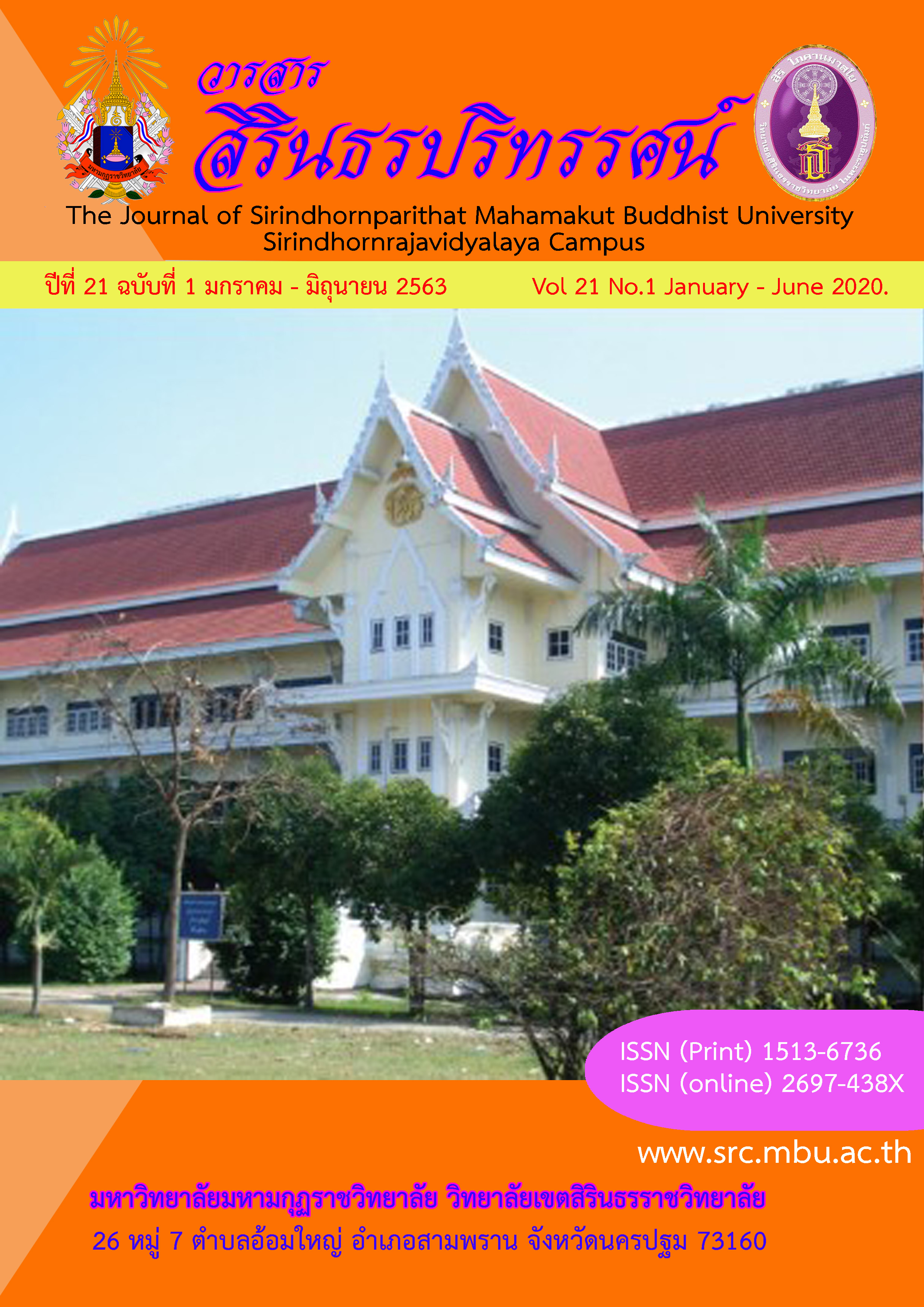Immunity to premature pregnancy of the teenagers with the principle of Khanti-Soracca of the teenagers in the metropolitan area
Keywords:
Immunity, Premature Pregnancy, Buddhist Principle of Khanti-SoraccaAbstract
The research had the adjectives as follows: To analyze the problematic states of the premature pregnancy, to study on how to apply the Buddhist principle of Khanti-Soracca to premature pregnancy of the teenagers in metropolitan area, and to create the model of Immunity for the premature pregnancy of the teenagers. The results of the research were found as follows: In connection with premature pregnancy problem, personal factors of the respondents were found that most of the teenagers were 15-16 years of age, they had lower secondary education, and their parents were employees of the companies. In connection with comparative analysis, comparison of Khanti-Soracca and premature pregnancy of teenagers in the metropolitan area, classified with different gender, age, educational level, and parental occupation, was found that overall was not different. But physical / mental aspects were significantly different at the 0.05 level, which was in accordance with the hypothesis. And in connection with Immune model of premature pregnancy with the principle of Khanti-Soracca, family members should create love, attachment, and understanding, which would create immunity for teenagers, and the principle of virginity before marriage should be adhered as well. All these would help reduce the risk behavior of mental changes and thoughts that affected teenagers having the opportunity to risk behavior in various fields, especially sexual risk behaviors by the words "don't, and stop ". This had to be the rejection that came from the true intention to avoid and protect oneself
References
กระทรวงการพัฒนาสังคมและความมั่นคงของมนุษย์. (2549). นโยบายและยุทธศาสตร์การพัฒนา สถาบันครอบครัว พ.ศ.2547-2556. กรุงเทพมหานคร: สํานักงานกิจการสตรีและสถาบันครอบครัว.
กฤตยา อาชวนิจกุล. (2554). เพศวิถีที่กำลังเปลี่ยนแปลงไปในสังคมไทย. กรุงเทพมหานคร: สำนักพิมพ์ประชากรและสังคม.
กฤษฎา ศุภวรรธนะกุล. (2550). หลุมดำ UNCENSORED 3. กรุงเทพมหานคร: พิมพ์บูรพา.
กรมอนามัย สำนักอนามัยการเจริญพันธ์ พระราชบัญญัติการป้องกันและแก้ไขปัญหาการตั้งครรภ์ ในวัยรุ่น พ.ศ. 2559
บุญชม ศรีสะอาดและบุญส่ง นิลแก้ว. (2535). การวิจัยเบื้องต้น. พิมพ์ครั้งที่ 6. มหาสารคาม : มหาวิทยาลัย ศรีนครินทรวิโรฒ.
ประพันธ์ โอประเสริฐ และสมพล พงศ์ไทย. (2534). การตั้งครรภ์ไม่วางแผนและการตั้งครรภ์ไม่ปรารถนา. สูติศาสตร์พื้นฐานรามาธิบดี. กรุงเทพมหานคร: ข้าวฟ่าง.
พระมหาอำนาจ พุทฺธิเมธี, (ม.ป.ป.), นวโกวาท ฉบับสมบูรณ์, กรุงเทพมหานคร : โรงพิมพ์เลี่ยงเซียง.
พระอุทิศ อภิวโร. “การศึกษาหลักพุทธธรรมเพื่อแก้ปัญหาชีวิตและเศรษฐกิจ” วิทยานิพนธ์ศาสนศาสตรมหาบัณฑิต. บัณฑิตวิทยาลัย มหาวิทยาลัยมหามกุฏราชวิทยาลัย, 2557. ระบบสถิติทางทะเบียน ข้อมูล : ณ วันที่ 4 มกราคม 2560.
วัลยา นิชวัฒน์. (2553). เพศศึกษาสำหรับวัยรุ่นไทย. วารสารสภาการพยาบาล.
ศิรินันท์ กิตติสุขสถิต, และคณะ.(2554). คู่มือการวัดความสุขด้วยตนเอง HAPPINOMETER. กรุงเทพมหานคร: โรงพิมพ์ธรรมดาเพรส
สุภาชัย สาระจรัส. (2553). ศึกษาการตั้งครรภ์ของเด็กวัยเยาว์ : การศึกษาเชิงปรากฏการณ์วิทยา.ดุษฎีนิพนธ์ปรัชญาดุษฎีบัณฑิต (การศึกษาและการพัฒนาสังคม). ชลบุรี :บัณฑิตวิทยาลัย มหาวิทยาลยบูรพา.
สุรีย์พร พันพึ่ง และมาลี สันภูวรรณ์. ประชากรและสังคม 2554 จุดเปลี่ยนประชากร จุดเปลี่ยนสังคมไทย. นครปฐม: เดือนตุลาคม
Downloads
Published
Issue
Section
License
บทความที่ได้รับการตีพิมพ์เป็นลิขสิทธิ์ของ มหาวิทยาลัยมหามกุฏราชวิทยาลัย วิทยาเขตสิรินธรราชวิทยาลัย
ข้อความที่ปรากฏในบทความแต่ละเรื่องในวารสารวิชาการเล่มนี้เป็นความคิดเห็นส่วนตัวของผู้เขียนแต่ละท่านไม่เกี่ยวข้องกับหาวิทยาลัยมหามกุฏราชวิทยาลัย วิทยาเขตสิรินธรราชวิทยาลัย และคณาจารย์ท่านอื่นๆในมหาวิทยาลัยฯ แต่อย่างใด ความรับผิดชอบองค์ประกอบทั้งหมดของบทความแต่ละเรื่องเป็นของผู้เขียนแต่ละท่าน หากมีความผิดพลาดใดๆ ผู้เขียนแต่ละท่านจะรับผิดชอบบทความของตนเองแต่ผู้เดียว




